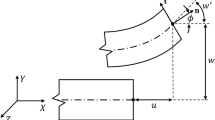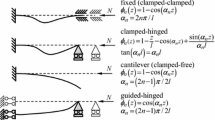Abstract
Three beams of rectangular cross-section and having same cross-sectional dimensions were tested in two-point bending, over an effective span of 4.2 m. All three beams contained steel only in the tension zone and the tension steel was distributed in three different ways. A deterministic analysis of strains, crack spacings and crack widths for all three beams is carried out and the results are compared with the respective experimental values. A probabilistic analysis of strains, crack spacings and crack widths is performed for all the three beams at different stages of loading.
Similar content being viewed by others
Abbreviations
- A ct :
-
Effective concrete area intension
- A st :
-
Area of tension reinforcement
- A st1 :
-
Area of tension reinforcement in top row (i.e. atd 1)
- A st2 :
-
Area of tension reinforcement in bottom row (i.e. atd 2)
- a c :
-
Average spacing of cracks
- a m :
-
Average spacing of cracks when they have just formed (i.e. atM=M cr for a flexural specimen)
- b :
-
Width of section
- D :
-
Total depth of the section
- d :
-
Effective depth
- d1,d2:
-
Depths to the two rows of reinforcing steel from extreme-compression fibre
- E s :
-
Modulus of elasticity of steel
- E c :
-
Modulus of elasticity of concrete (initial tangent modulus)
- f bu :
-
Ultimate bond strength
- f ct :
-
Tensile strength of concrete
- f c :
-
Compression strength of concrete cylinder
- f r :
-
Modulus of rupture of concrete
- f y :
-
Yield strength of reinforcement
- h 1 :
-
Depth to the level at which strain is required
- I :
-
Moment of inertia of cross-section
- I g :
-
Moment of inertia of uncracked crosssection
- I cr :
-
Moment of inertia of cracked transformed section
- k b :
-
Factor giving average bond stress (k b=2/3 in this investigation)
- k t :
-
Factor giving average tensile stress (k t=2/3 in this investigation)
- l :
-
Effective span of beam
- l 1 :
-
Distance of section XX from an already formed crack
- M :
-
External moment
- M cr :
-
Cracking moment
- M u :
-
Ultimate moment
- R :
-
Rate of loading (35 psi sec−1)
- W as :
-
Average crack width at the level of steel
- W ms :
-
Maximum crack width at the level of steel
- x :
-
Neutral axis depth of a cracked section
- γ:
-
A constant (=0.33 in this study)
- ɛs :
-
Strain in reinforcement
- σbs :
-
Maximum bond stress
- σsr :
-
Steel stress at first cracking
- σtx :
-
Maximum tensile stress in the effective concrete at section XX
- ϕ:
-
Diameter of bar
- μ:
-
Mean
- σ:
-
Standard deviation
- COV:
-
Coefficient of variation
- Ωccyl :
-
Compression cylinder strength coefficient of variation
- P :
-
Effective reinforcement ratioA st/A ct
References
Gergely, P. and Lutz, L.A., ‘Maximum crack width in reinforced concrete flexural members. Causes, mechanism and control of cracking in concrete’, in ACI Special Publication SP-20 (American Concrete Institute, Detroit, 1968), pp. 87–117.
Beeby, A.W., ‘The prediction and control of flexural cracking in reinforced concrete members’, Paper no SP30-3 inCracking, deflection and ultimate load of concrete slab systems, ACI Publication SP-30 (American Concrete Institute, Detroit, 1971), pp. 55–75.
CEB/FIP,Model Code for Concrete Structures (English edition, Cement and Concrete Association, London) (1978), pp. 151–164.
Desayi, P., ‘Determination of maximum crack width in reinforced concrete members’,J. Amer. Conc. Inst. Proc. 73, (1976), 473–477.
Desayi, P. and Ganesan, N., ‘An investigation on spacing of cracks and maximum crack width in reinforced concrete flexural members’,Mat. Struct. 18 (1985) (104) 123–133.
Mirza, Sher Ali and MacGregor, J.C., ‘Statistical study of shear strength of reinforced concrete slender beams’,J. Amer. Concr. Inst. Proc. 76 (1979) (11) 1159–1178.
Ramsay, R.J., Mirza, Sher Ali and MacGregor, J.G., ‘Monte Carlo study of short time deflection of reinforced concrete beams’, ibid.J. Amer. Concr. Inst. Proc. 76 (1979) (8) 897–918.
The Code of Practice for the Structural Use of Concrete, CP110, Part 1 (British Standards Institution, London, 1972).
Warner, R.F. and Kabila, A.P., ‘Monte Carlo study of structural safety’,Proc. ASCE, J. Struct. Div. 94 (1968) (ST12) 2847–2860.
Tichy, M. and Varlicek, M.,Statistical theory of concrete structures, with special reference to ultimate design (Irish University Press, Shannon; Academia, Prague, 1972).
Mirza, Sher Ali and MacGregor, J. G., ‘Variability of mechanical properties of reinforcing bars’,Proc. ASCE J. Struct. Div. 105, (1979) (ST5) 921–937.
Idem, ‘Probabilistic study of strength of reinforced concrete members’,Can. J. Civil Eng.9, (1982) 431–448.
Bhasin, P.C. and Chakrabarti, S.P., ‘Design specifications for limit state of crack width in flexure’, Panel discussion of the 40th Annual session of the Indian Roads Congress, Jaipur, India, February 1980.
Author information
Authors and Affiliations
Rights and permissions
About this article
Cite this article
Desayi, P., Rao, K.B. Probabilistic analysis of the cracking of RC beams. Materials and Structures 20, 408–417 (1987). https://doi.org/10.1007/BF02472491
Published:
Issue Date:
DOI: https://doi.org/10.1007/BF02472491




